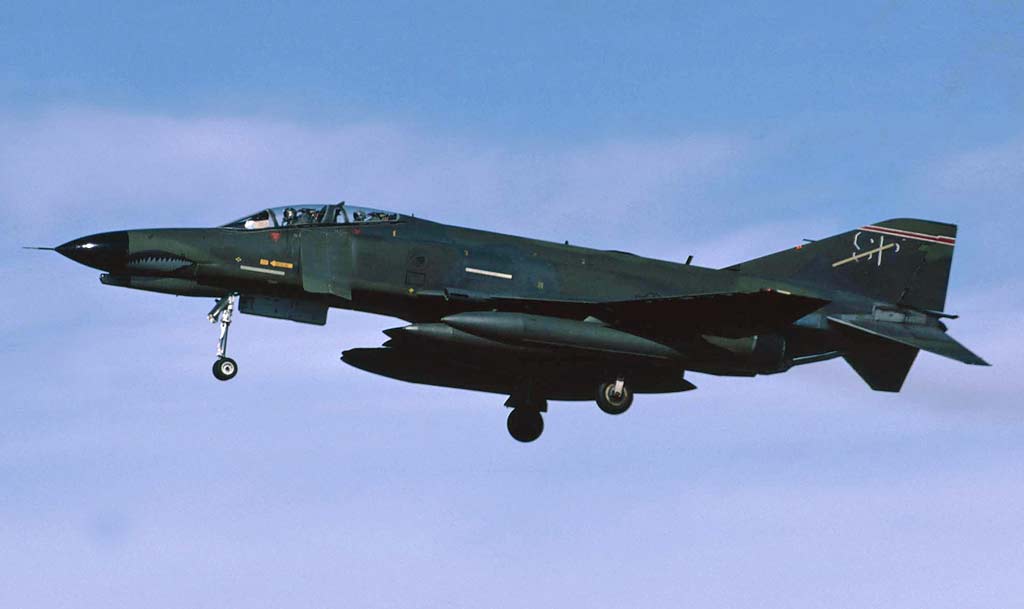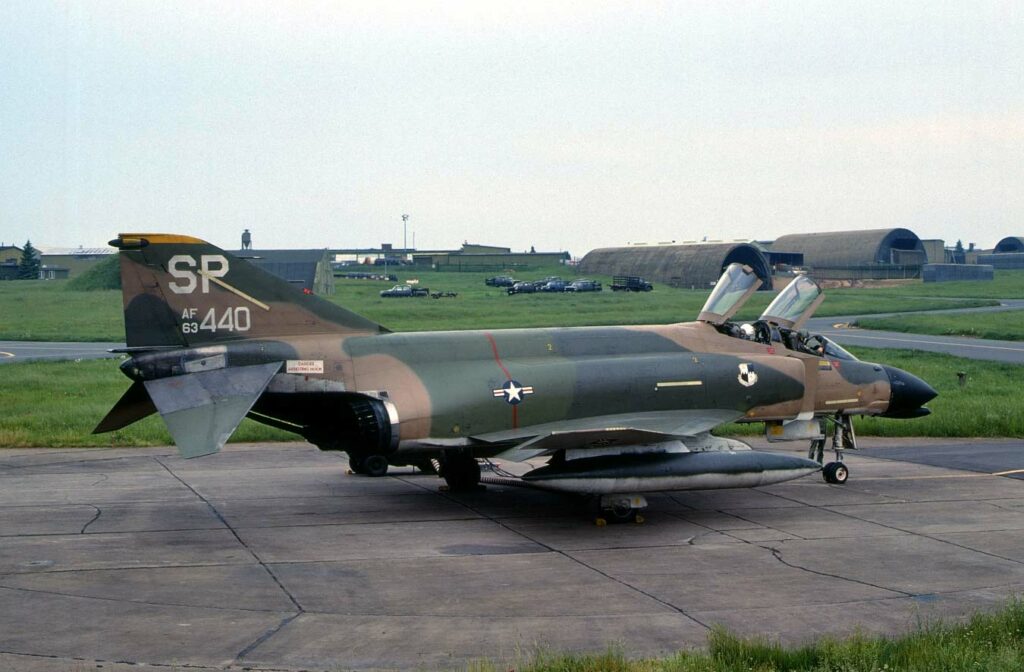The F-4 Wild Weasel is a specialized variant of the McDonnell Douglas F-4 Phantom II, designed for SEAD missions to detect, identify, and neutralize enemy radars.
In brief
The McDonnell Douglas F-4 Wild Weasel, a variant of the iconic F-4 Phantom II, was adapted for the Suppression of Enemy Air Defenses (SEAD) role. Equipped with advanced electronic warfare equipment, it specialized in identifying, locating, and destroying enemy radar and Surface-to-Air Missile (SAM) installations. The aircraft featured AGM-45 Shrike, AGM-78 Standard, and later AGM-88 HARM missiles specifically designed for SEAD missions. Alongside its potent electronic countermeasures suite, it retained the Phantom’s versatile combat capabilities, including air-to-air missiles and a significant bomb load, making it a formidable asset in protecting strike packages from air defense threats.

History of the Development of the McDonnell Douglas F-4 Wild Weasel
In the heat of the Vietnam War, U.S. air forces faced significant threats from North Vietnamese Surface-to-Air Missile (SAM) systems and radar-guided anti-aircraft artillery. The need for a solution led to the inception of the “Wild Weasel” concept: aircraft explicitly tasked with the SEAD role. The program was initiated to develop a platform capable of neutralizing the SAM threat, enhancing the survivability of strike formations.
The McDonnell Douglas F-4 Phantom II, already renowned for its versatility and performance, was chosen as the base airframe for the Wild Weasel variant. The first iteration, the F-4C Wild Weasel IV, flew missions in the late 1960s, with subsequent versions like the F-4G Wild Weasel V becoming more sophisticated. The F-4G, introduced in the late 1970s, incorporated advanced avionics, including the APR-38 radar homing and warning system, which was later upgraded to the APR-47. These aircraft were pivotal in evolving SEAD tactics and technology, providing crucial protection against enemy air defenses.
Design of the McDonnell Douglas F-4 Wild Weasel
The F-4 Wild Weasel was distinctively outfitted with electronic warfare equipment designed to detect, deceive, and destroy enemy radar and SAM sites. The airframe modifications included the installation of radar warning receivers, jamming pods, and missile launch detection systems. The most advanced Wild Weasel, the F-4G, was equipped with the AN/APR-38 radar homing and warning system, which could locate threats by their electronic emissions and target them with anti-radiation missiles.
The aircraft maintained the F-4 Phantom’s two-seat configuration, with the pilot focusing on flying the aircraft while the Electronic Warfare Officer (EWO) managed the sophisticated SEAD equipment. This design allowed for effective teamwork in managing the complex systems and responding to threats during high-stakes SEAD missions.
Performance of the McDonnell Douglas F-4 Wild Weasel
The F-4 Wild Weasel’s performance characteristics were largely inherited from the F-4 Phantom II, including its two General Electric J79 engines, providing a top speed of over Mach 2 and a service ceiling above 60,000 feet. Its combat radius and loiter time over the battlefield were enhanced by its in-flight refueling capability, ensuring prolonged presence during missions. The aircraft could carry a mix of AGM-45 Shrike and AGM-88 HARM missiles, along with traditional air-to-air armament, making it capable of engaging a variety of targets, from ground radar installations to enemy aircraft.
Variants of the McDonnell Douglas F-4 Wild Weasel
The Wild Weasel variants of the F-4 Phantom II included:
- F-4C Wild Weasel IV: The initial SEAD variant, modified from the F-4C Phantom.
- F-4G Wild Weasel V: An advanced version with improved avionics and the capability to carry AGM-88 HARM missiles, based on the F-4E airframe.

Military Use and Combat of the McDonnell Douglas F-4 Wild Weasel
The F-4 Wild Weasel variants were combat-proven platforms, extensively used in the Vietnam War, Operation Desert Storm, and other conflicts where the U.S. faced sophisticated integrated air defense systems (IADS). Their mission was to escort strike packages, using their onboard equipment to detect and suppress or destroy enemy radar and SAM sites, thereby clearing the path for the main strike force.
The effectiveness of the Wild Weasels was demonstrated in numerous engagements where they successfully neutralized enemy air defenses, significantly reducing the risks to accompanying strike aircraft. Their bravery and crucial role earned Wild Weasel crews a legendary status. Post-Vietnam, the F-4G Wild Weasel Vcontinued to play a vital role in U.S. military operations, most notably during Operation Desert Storm in 1991. In this conflict, the F-4G Wild Weasel units were crucial in suppressing Iraqi air defenses, employing AGM-88 HARM missiles with precision to neutralize the threat of surface-to-air missiles and anti-aircraft artillery, thereby safeguarding allied air forces during the extensive aerial campaign.
Their operations were not just limited to preemptive strikes on static air defense sites but also included dynamic targeting of mobile SAM systems and radar units, showcasing the aircraft’s flexibility and the crew’s adeptness in adapting to the evolving battlefield conditions. The Wild Weasels’ unique mission set and their crews’ expertise in SEAD operations granted them a reputation as “force multipliers,” significantly enhancing the overall effectiveness and safety of air operations.
The missions often involved flying into heavily defended enemy territory, requiring immense skill, courage, and resilience from both the pilots and electronic warfare officers. The tactics developed and refined by Wild Weasel crews over years of operational experience have become a cornerstone of modern electronic warfare and SEAD doctrine, influencing subsequent generations of aircraft and mission planning.
–
The McDonnell Douglas F-4 Wild Weasel variants epitomized the evolution of SEAD capabilities in modern air warfare, adapting over time to meet the challenges of sophisticated enemy air defenses. The aircraft’s development from the F-4 Phantom platform demonstrated innovative engineering solutions to the complex problem of suppressing enemy air defenses effectively. The Wild Weasel missions were pivotal in ensuring air superiority and the safety of strike packages, proving the concept’s value and setting the foundation for future SEAD platforms and tactics.
Through its operational history, the F-4 Wild Weasel garnered respect for its crucial role in electronic warfare, its contribution to air combat strategy, and the bravery of its crews. Even as newer technologies and platforms have taken its place, the legacy of the F-4 Wild Weasel continues to influence modern SEAD operations, underscoring its lasting impact on aerial warfare and electronic countermeasure tactics. The aircraft’s storied career remains a testament to the ingenuity and courage that define the best of military aviation.
Back to the Special Aircraft section